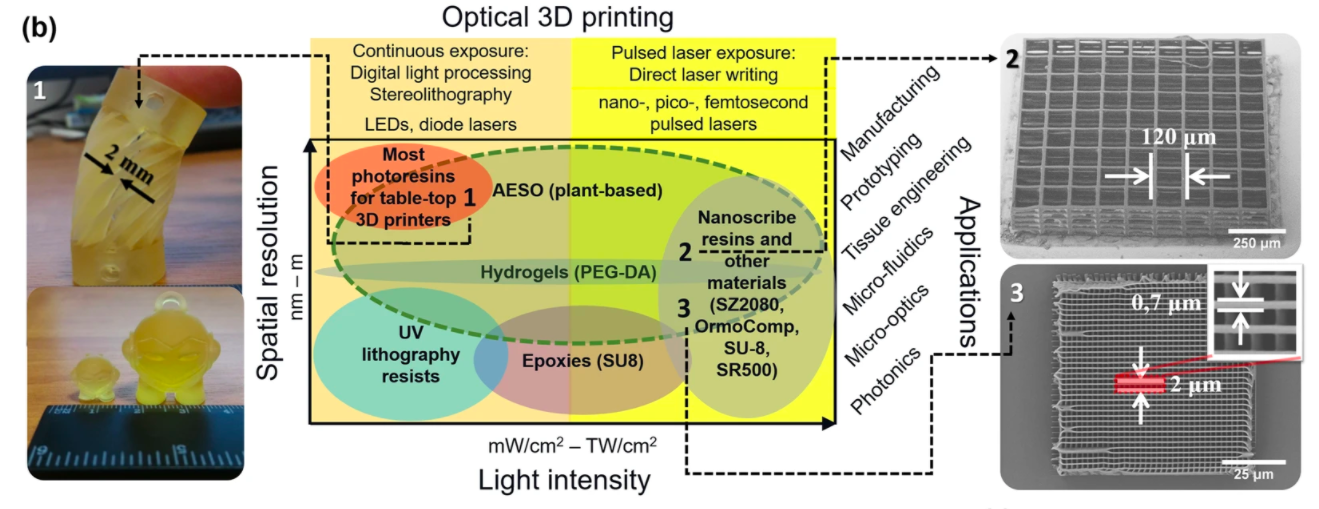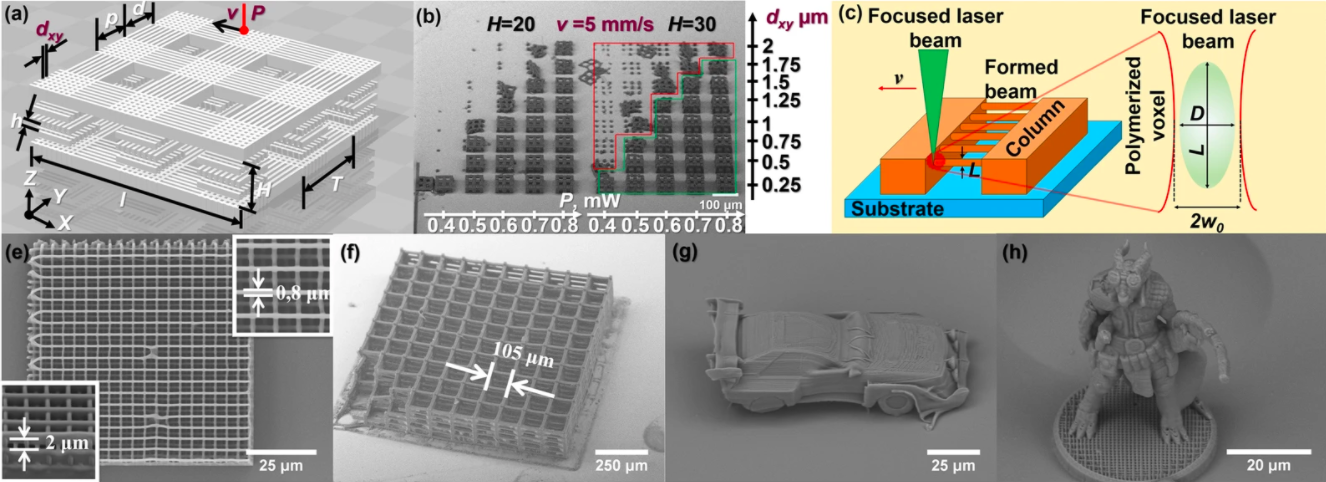Researchers from the Lithuania-based Vilnius University and the Kaunas University of Technology have developed an environmentally-friendly, recyclable resin for use within the Optical 3D printing (O3P) process.
Derived from soybeans, the bio-resin fulfils the technological, functional and durability requirements of conventional polymers used in 3D printing, while offering increased bio-compatibility at a lower cost. The new biomaterial could be used in small batch production services, moving O3DP manufacturing towards employing bio-based resins, instead of non-recyclable petroleum-derived photopolymers.

A greener alternative to photopolymers in 3D printing
Bio-based polymers are increasingly being adopted within the 3D printing industry as an alternative to photopolymers due to their carbon neutrality, biodegradability, and recyclability. Vegetable oil for instance, is widely available, and can be used as a starting material for many polymer-substitutes, while displaying an inherent degradability and low toxicity. O3DP methods, meanwhile, have also been developed as a way of achieving low waste production, but many still rely on petroleum-derived resins.
O3DP manufacturing methods offer many benefits, such as its integration of post-processing, which allows for the fabrication of free-form structures that serve as 3D templates for producing pure glass, ceramic and metal objects. In addition, the production techniques allow the flexible manufacturing of multi-dimensional, hierarchical, or arbitrary structures, which accelerates the 3D printing process within a range of applications.
In order to continue reaping the benefits of O3DP printing, albeit in a more environmentally-friendly way, the Lithuanian researchers devised their new biopolymer. The resin, constructed from soybean extracts, is suitable for O3DP in the scales from nano- (hundreds nm) to macro-dimensions (cm). Moreover, by optimizing pulsed-exposure during printing, the resin can be processed purely, and without the need to add any artificial photoinitiators (PIs).

Testing and analyzing the eco-friendly resin
Depending on their applications, resins require different irradiation intensities and achievable resolutions, and the team chose Acrylated Epoxidized SoyBean Oil (AESO) to demonstrate the bio-based resin’s applicability in O3DP. Most desktop 3D printers for example, are compatible with acrylate or methacrylate-based resins for the prototyping of macro-scale objects. Nanoscribe on the other hand, provides a multi-scale 2PP material, but it actually uses three different photoresins, which are designed to produce parts for each spatial scale. According to the Lithuanian team then, there was no single photo resin capable of enabling truly scalable manufacturing.
The AESO material meanwhile, has the advantage of being suitable for manufacturing objects that span five orders of magnitude. Moreover, according to the researchers, it’s not just the absence of light-absorbing compounds such as PIs, that makes their bio-resin suitable for use with O3DP methods. The final chemical formulation, physical characteristics, viscosity and reaction mechanisms of the material, also have a significant impact in determining its 3D photo structuring qualities and recyclability.
Using Deep Light Projector (DLP) 3D printing on a standard Formlabs Form 2 optical system, the Lithuanian team produced a series of bench-marking samples on different scales. The models included two chess-style pieces named “Tower” and “Marvin,” a Nonlinear Lithography (NLL)- printed scaffold structure, and grating which reached up to hundreds μm of external dimensions, and only a few μm of individual features. According to the team, the characteristics of these parts proved their resin’s suitability for commercially delivering small batch production services on demand, in addition to rapid prototyping.
Asiga Pico2 39 UV and Autodesk Ember DLP 3D printers were summarily used to test the custom-made resins for linear absorption and suitability for macroscale additive manufacturing. The printed objects displayed similar layer thicknesses to those produced using polymer resins, and additional NLL testing used a common laser lithography setup that was convenient for 3D printing precise mm-scale prototypes. Additionally, fine-manufacturing of the periodic structures with feature sizes smaller than 1 μm was demonstrated, meaning that production was not limited to bulky monolithic objects.
Overall, the AESO resin had demonstrable performance advantages over existing resins used with O3DP, as it can be processed with either DLP or NLL printing, while maintaining over 60% of its bio-renewable carbon. In addition, the rheological and optical properties of AESO were easily modified by mixing it with diluents and PIs, enabling the team to produce multi-scale (from hundreds nm to cm) objects from a single material.
The mechanical properties of the AESO resin such as its elastic modulus, tensile strength and elongation at break, are still being investigated and results will be published separately according to the team. Nonetheless, the resin’s demonstrated compatibility with a range of O3DP techniques, could make it radically simpler and more affordable for desktop 3D printer owners to manufacture products, and in a more eco-friendly way.

Environmentally-friendly initiatives in 3D printing
A series of studies have been commissioned in recent years, aiming to assess the overall environmental impact of 3D printing.
Global trade group Additive Manufacturer Green Trade Association (AMGTA) for instance, announced a systematic review into the environmental sustainability of metal 3D printing in June 2020. The organization’s first literary-based appraisal aims to promote the green benefits of additive manufacturing.
Researchers from The Massachusetts Institute of Technology (MIT), Yale University and the University of Nottingham warned that the eco-benefits of 3D printing had been overestimated in September 2018. The team’s research suggested that on-demand 3D printing and rapid prototyping could lead to “dramatic increases in throw-away consumer products.”
In December 2017, a special edition of the “Journal of Industrial Ecology” produced at the Yale School of Forestry & Environmental Studies (F&ES) warned that it was too early to conclude that 3D printing was sustainable. The researchers noted that most research had gone into the benefits rather than the drawbacks of 3D printing’s eco-impact.
The researchers’ findings are detailed in their paper titled “A Bio-Based Resin for a Multi-Scale Optical 3D Printing” published in the Scientific Reports journal on June 16th 2019. The report was co-authored by Edvinas Skliutas, Migle Lebedevaite, Sigita Kasetaite, Sima Rekštytė, Saulius Lileikis, Jolita Ostrauskaite and Mangirdas Malinauskas.
You can now nominate for the 2020 3D Printing Industry Awards. Cast your vote to help decide this year’s winners.
To stay up to date with the latest 3D printing news, don’t forget to subscribe to the 3D Printing Industry newsletter or follow us on Twitter or liking our page on Facebook.
Looking for a job in the additive manufacturing industry? Visit 3D Printing Jobs for a selection of roles in the industry.
Featured image shows the polymerization process used by the researchers in the development of their eco-resin. Image via Scientific Reports.



